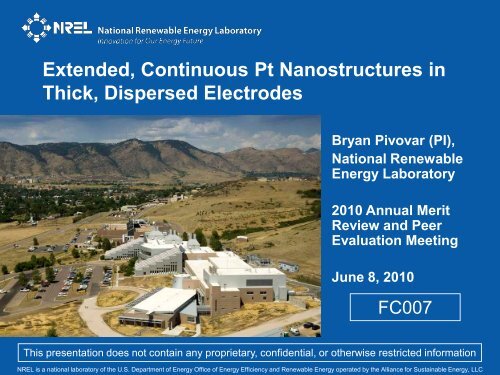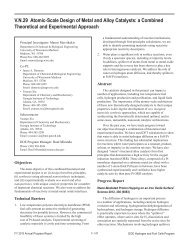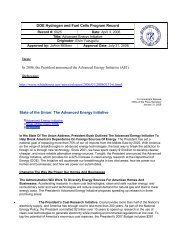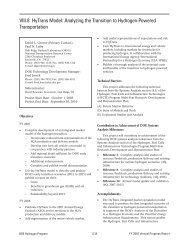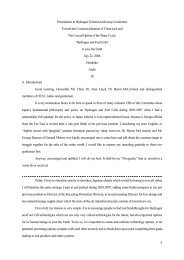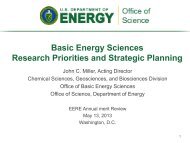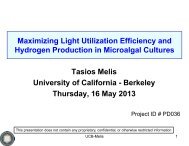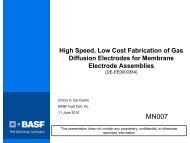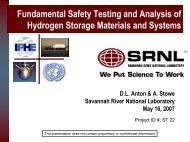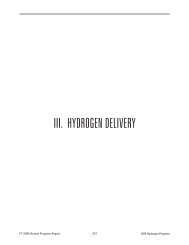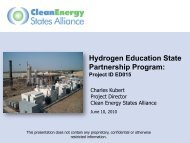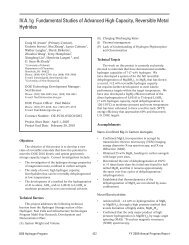Extended, Continuous Pt Nanostructures in Thick, Dispersed ...
Extended, Continuous Pt Nanostructures in Thick, Dispersed ...
Extended, Continuous Pt Nanostructures in Thick, Dispersed ...
You also want an ePaper? Increase the reach of your titles
YUMPU automatically turns print PDFs into web optimized ePapers that Google loves.
<strong>Extended</strong>, <strong>Cont<strong>in</strong>uous</strong> <strong>Pt</strong> <strong>Nanostructures</strong> <strong>in</strong><br />
<strong>Thick</strong>, <strong>Dispersed</strong> Electrodes<br />
Bryan Pivovar (PI),<br />
National Renewable<br />
Energy Laboratory<br />
2010 Annual Merit<br />
Review and Peer<br />
Evaluation Meet<strong>in</strong>g<br />
June 8, 2010<br />
FC007<br />
This presentation does not conta<strong>in</strong> any proprietary, confidential, or otherwise restricted <strong>in</strong>formation<br />
NREL is a national laboratory of the U.S. Department of Energy Office of Energy Efficiency and Renewable Energy operated by the Alliance for Susta<strong>in</strong>able Energy, LLC
National Renewable Energy Laboratory<br />
Innovation for Our Energy Future<br />
Overview<br />
Timel<strong>in</strong>e<br />
Start: July 2009<br />
End: September 2013<br />
% complete: 7%<br />
Barriers<br />
Budget<br />
DOE Cost<br />
Share<br />
Recipient<br />
Cost Share<br />
TOTAL<br />
$8,384,342 $867,763 $9,252,105*<br />
91% 9% 100%<br />
Budget ($K)<br />
FY 2009 1480<br />
FY 2010 1203<br />
FY 2011 2177<br />
FY 2012 2015<br />
FY 2013 1508<br />
*F<strong>in</strong>al award amounts are subject to<br />
appropriations and award negotiations.<br />
Partners<br />
Oak Ridge National Laboratory (ORNL)<br />
Los Alamos National Laboratory (LANL)<br />
University of California-Riverside (UC-R)<br />
State University of New York – Albany (CNSE)<br />
Stanford University (Stanford)<br />
University of Tennessee (Tenn)<br />
University of Texas-Aust<strong>in</strong> (Texas)<br />
Nissan Technical Center North America* (NTCNA)<br />
Cabot Fuel Cells* (Cabot)<br />
Tanaka Kik<strong>in</strong>zoku Kogyo* (TKK)<br />
*non-subcontracted collaborators<br />
*Project Kickoff Meet<strong>in</strong>g 7/27/09<br />
2
National Renewable Energy Laboratory<br />
Innovation for Our Energy Future<br />
Relevance (I)<br />
<strong>Extended</strong>, <strong>Cont<strong>in</strong>uous</strong> <strong>Pt</strong> <strong>Nanostructures</strong><br />
Novel Synthesis<br />
Objective: Produce novel catalysts based<br />
on extended <strong>Pt</strong> surfaces with <strong>in</strong>creased<br />
activity and durability<br />
3M’s (and others) demonstrated<br />
improvements <strong>in</strong> specific activity and durability<br />
(bottom center and right) us<strong>in</strong>g similar<br />
materials have shown significant promise.<br />
This project focuses on limitations <strong>in</strong> terms of<br />
mass activity and water management (next 2<br />
slides).<br />
<strong>Pt</strong> nanotubes (UC-R)<br />
<strong>Pt</strong> coated carbon nanotubes (NREL)<br />
Specific Activity at 900 mV (mA/cm2)<br />
3<br />
2.5<br />
2<br />
1.5<br />
1<br />
0.5<br />
0<br />
<strong>Pt</strong> Polycrystall<strong>in</strong>e*<br />
<strong>Pt</strong> Black*<br />
<strong>Pt</strong>/C (20%) Vulcan*<br />
DOE Status<br />
DOE Target<br />
*Gasteiger et al., Appl. Catal. B: Environ., 56, 9-35 (2005)<br />
*http://www.hydrogen.energy.gov/pdfs/review09/fc_17_debe.pdf<br />
3
National Renewable Energy Laboratory<br />
Innovation for Our Energy Future<br />
Relevance (II): Improved mass activity<br />
Particle<br />
<strong>Pt</strong> Shells Surface <strong>Pt</strong><br />
2 nm cubooctahedron 5 52%<br />
5 nm cubooctahedron 12 24%<br />
12.5 nm <strong>Pt</strong> coated(50 nm core) cyl<strong>in</strong>der 29 ~5%<br />
Mark Debe, 3M, DOE Annual Merit Reviews<br />
http://www.hydrogen.energy.gov/pdfs/review07/fcp_25_debe.pdf,<br />
http://www.hydrogen.energy.gov/pdfs/review09/fc_17_debe.pdf<br />
Gancs et al. Chem. Mater. 2008, 20, 2444–2454<br />
Objective: Further <strong>in</strong>crease mass<br />
activity of extended surface catalysts<br />
3M’s approach (while exceptionally<br />
promis<strong>in</strong>g) has limits related to the use of<br />
nonconductive substrates and l<strong>in</strong>e of sight<br />
deposition process.<br />
4
National Renewable Energy Laboratory<br />
Innovation for Our Energy Future<br />
Relevance (III)<br />
<strong>Dispersed</strong> Electrode Studies<br />
20 nm<br />
LANL cathode layer<br />
25 nm<br />
SEM of 3M’s NSTF MEA<br />
http://www.hydrogen.energy.gov/pdfs/review04/fc_4_debe.pdf<br />
HR-TEM Karren More ORNL<br />
Electrode Studies<br />
Objective: Effectively <strong>in</strong>corporate extended <strong>Pt</strong> catalysts <strong>in</strong>to<br />
more traditional dispersed electrodes for mass<br />
transport/water management<br />
<strong>Dispersed</strong> (traditional) electrodes (~10 µm) have shown<br />
exceptional tolerance over wide ranges of operat<strong>in</strong>g conditions,<br />
<strong>in</strong>clud<strong>in</strong>g those relevant for transportation applications (hot/dry<br />
and cold/wet). To date, such structures have not been<br />
demostrated with extended <strong>Pt</strong> surfaces. Inherent electronic<br />
connectivity may help over come “particle-size” related effects.<br />
Ionomer <strong>in</strong>clusion <strong>in</strong> catalyst layer may help cold start.<br />
5
Approach: Overview<br />
1. Novel Synthesis<br />
a. Core/Templates<br />
b. <strong>Pt</strong> Deposition<br />
2. Electrode Studies<br />
3. Model<strong>in</strong>g<br />
Project Timel<strong>in</strong>e (Table of associated Milestones and Decision Po<strong>in</strong>ts follows)<br />
Task* Q1 Q2 Q3 Q4 Q5 Q6 Q7 Q8 Q9 Q10 Q11 Q12 Q13 Q14 Q15 Q16<br />
1ai M MG M MG<br />
1aii M G MG M<br />
1aiii M MG M M<br />
1aiv M MG M<br />
1bi a M M MG<br />
1bi b M M M MG MG<br />
1bii M M M M MG MG<br />
2a M MG M<br />
2b M M MG MG MG<br />
3 c M M M<br />
3 d M M M<br />
*Task descriptions can be found <strong>in</strong> Work Plan Outl<strong>in</strong>e, a PVD coat<strong>in</strong>gs; b ALD coat<strong>in</strong>gs; c catalyst model<strong>in</strong>g; d electrode model<strong>in</strong>g<br />
Q represents quarter from start date; M represents Milestones; G represents go/no-go decisions<br />
Milestones due and go/no-go decisions enacted at end of quarter <strong>in</strong> which they appear<br />
active task dur<strong>in</strong>g quarter; active task dur<strong>in</strong>g quarter pend<strong>in</strong>g go/no-go decision; <strong>in</strong>active task<br />
Milestones<br />
Go/no-go decisions focus primarily on down selection of substrates and deposition processes<br />
to those of novel structures show<strong>in</strong>g targeted/improved performance and durability.<br />
Supply first generation carbon nanotubes, metal oxide nanoparticles, and whiskers for <strong>in</strong>itial<br />
plat<strong>in</strong>um deposition studies.<br />
Synthesize 1st generation <strong>Pt</strong> coated nanostructures by physical vapor deposition for electrochemical<br />
characterization.<br />
Supply 1st generation <strong>Pt</strong> nanotubes synthesized from Ag nanowires for electrochemical test<strong>in</strong>g and<br />
electrode studies.<br />
Go/no-go decision for 1st generation CNTs. Based on <strong>in</strong>itial studies of CNTs by coat<strong>in</strong>g techniques<br />
if cont<strong>in</strong>uous coat<strong>in</strong>gs are not obta<strong>in</strong>ed beg<strong>in</strong> 2nd generation CNT synthesis.<br />
Complete parametric study of <strong>Pt</strong>NT production as <strong>in</strong>fluenced by <strong>Pt</strong> supplied, reaction time, <strong>Pt</strong> surface<br />
area, and result<strong>in</strong>g wall thickness.<br />
09/09<br />
Complete<br />
09/09<br />
Complete<br />
09/09 delayed due to subcontract<strong>in</strong>g<br />
issues<br />
12/09<br />
Complete<br />
05/10<br />
Demonstrate (at least 3) 1st generation cont<strong>in</strong>uous nanostructured <strong>Pt</strong> catalysts <strong>in</strong> fuel cell test<strong>in</strong>g. 09/10<br />
6<br />
National Renewable Energy Laboratory<br />
Innovation for Our Energy Future
Approach<br />
(1a) Core/Templates<br />
Template (Prioritized) Advantages Disadvantages<br />
*adapted from Majidi, E., & Gates, B. (2007), mrs.org, 1017.<br />
Unreactive<br />
faces*<br />
Metal (wires, tubes, etc)<br />
(UC-R, NREL)<br />
Highly conductive<br />
Alloy improvements<br />
Galvanically displaceable<br />
Controlled surface structure<br />
Catalytic <strong>in</strong>hibitors<br />
Stability under operat<strong>in</strong>g<br />
conditions<br />
Limited materials/<br />
morphologies<br />
Reactive<br />
faces<br />
Carbon Nanotubes (CNTs)<br />
(NREL)<br />
Metal oxides*<br />
(CNSE, NREL)<br />
Highly conductive<br />
High corrosion resistance<br />
Carbon abundance<br />
Dopants<br />
Surface modification<br />
Many different materials<br />
Many demonstrated<br />
structures<br />
Cost (although still cheap<br />
compared to <strong>Pt</strong>)<br />
Poor wettability<br />
Process<strong>in</strong>g<br />
Limited chemistries/<br />
morphologies<br />
Conductivity/Corrosion<br />
resistance (<strong>in</strong> many cases)<br />
NREL (VACNTs)<br />
NREL (WO 3 )<br />
Whiskers*<br />
(NREL)<br />
Cost<br />
Corrosion resistant<br />
Demonstrated/Optimized <strong>in</strong><br />
3M’s NSTF<br />
Non-conductive<br />
Limited morphologies<br />
NREL (Whiskers)<br />
*see supplemental slides 28-29 for more detail.<br />
National Renewable Energy Laboratory<br />
7<br />
Innovation for Our Energy Future
Approach<br />
(1b) <strong>Pt</strong> Deposition/ Coat<strong>in</strong>g Techniques<br />
Vapor Deposition (evaporation, CVD, PLD)<br />
sputter<strong>in</strong>g<br />
atomic layer deposition* (ALD)<br />
Solution Deposition (electrochemical, spontaneous, underpotential)<br />
spontaneous galvanic displacement<br />
Specific Issues Considered<br />
L<strong>in</strong>e of sight vs. non-l<strong>in</strong>e of sight<br />
Inherent difficulty of form<strong>in</strong>g<br />
cont<strong>in</strong>uous th<strong>in</strong> <strong>Pt</strong> sk<strong>in</strong>*<br />
*see supplemental slides 30-34 for more detail.<br />
National Renewable Energy Laboratory<br />
8<br />
Innovation for Our Energy Future
Approach<br />
(2) Electrode Studies<br />
We will perform electrode<br />
studies that specifically<br />
<strong>in</strong>clude extended-surface<br />
catalysts.<br />
These studies will build off of<br />
work our team has performed<br />
on traditional systems,<br />
coupl<strong>in</strong>g electrochemical<br />
properties (ECSA, activity,<br />
durability with structure and<br />
composition). *<br />
Factors <strong>in</strong>vestigated will <strong>in</strong>clude<br />
porosity, composition,<br />
process<strong>in</strong>g, and architecture<br />
(to better assess<br />
performance and durability).<br />
ECSA (m 2 /g)<br />
80<br />
70<br />
60<br />
50<br />
40<br />
30<br />
20<br />
10<br />
0<br />
w/o H2SO4<br />
w/ H2SO4<br />
1 : 1 1 : 2 1 : 10<br />
Nafion ® to Carbon Weight Ratio<br />
20 nm<br />
*<br />
H. Xu, E. Brosha, F. Garzon, F. Uribe, M. Wilson, and B.<br />
Pivovar, ECS Transactions, 2007; 11, 1, 383.<br />
*H. Xu, E. Brosha, K. More, F. Uribe,<br />
F. Garzon, B. Pivovar, <strong>in</strong> prep.<br />
*see supplemental slides 41-43 for more detail.<br />
National Renewable Energy Laboratory<br />
100 nm<br />
Electrode Structure<br />
20% <strong>Pt</strong>/C<br />
TEM, ORNL<br />
9<br />
Innovation for Our Energy Future
Approach<br />
(3) Model<strong>in</strong>g Studies<br />
Our development of novel catalysts and<br />
implementation <strong>in</strong> electrodes will be<br />
supported through (NREL) coord<strong>in</strong>ated<br />
model<strong>in</strong>g efforts. 3 Thrusts*:<br />
1. Simulations <strong>in</strong>volv<strong>in</strong>g <strong>Pt</strong> film and<br />
extended <strong>Pt</strong> structure formation<br />
(Tenn).<br />
2. Simulations of architectures based on<br />
extended <strong>Pt</strong> structures <strong>in</strong>to “thick”<br />
electrode structures (Tenn).<br />
3. Simulations of the performance of<br />
fuel cells based on thick electrodes<br />
with extended structure <strong>Pt</strong> catalysts<br />
(Texas).<br />
*see supplemental slides 42-46 for more detail.<br />
National Renewable Energy Laboratory<br />
Simulations developed to describe <strong>Pt</strong> particle size<br />
and structure on carbon supports will be expanded to<br />
<strong>in</strong>clude other approaches taken <strong>in</strong> the project.<br />
3D simulations take <strong>in</strong>to account<br />
composition of electrodes.<br />
λ,Φionomer<br />
Φsolid<br />
pliq, S<br />
pgas, pO2<br />
Extension of established<br />
porous electrode models<br />
to highlight issues<br />
critical to the<br />
<strong>in</strong>corporation of<br />
extended surfaces <strong>in</strong><br />
thick, dispersed<br />
electrodes<br />
10<br />
Innovation for Our Energy Future
Technical Accomplishments and Progress<br />
Metal Templates<br />
Cu Nanowires (NREL)<br />
Ag and Se nanowires<br />
demonstrated as templates<br />
for <strong>Pt</strong> and <strong>Pt</strong>Ru nanowires<br />
(UC-R). 1<br />
Microwave assisted surfactant mediated growth (wet chemical process)<br />
Cu nanowires much less<br />
studied (NREL), we have<br />
developed novel (quicker,<br />
potentially cheap) route.<br />
Cu has been used for<br />
similar galvanic<br />
displacements reactions. 2<br />
<strong>Pt</strong>-Cu alloys shown to be<br />
advantageous for activity. 3<br />
[1] Z. Chen, W. Li, M. Waje, Y. S. Yan, Angew. Chem. Int. Ed. 2007, 46:4060-4063.; VIP and Frontpiece Picture<br />
[2] J. Zhang, F.H.B. Lima, M. H. Shao, K. Sasaki, J.X. Wang, J. Hanson, R. R. Adzic, J. Phys. Chem. B, 109 (2005) 22701-22704.<br />
11<br />
[3] R. Srivastava, P. Mani, N. Hahn, P. Strasser, Angew. Chem. Int. Ed. 46 (2007), 8988.<br />
National Renewable Energy Laboratory<br />
Innovation for Our Energy Future
Technical Accomplishments and Progress<br />
Carbon Nanotubes (CNTs)<br />
Mean<strong>in</strong>gful effort <strong>in</strong> this area. Included the<br />
<strong>in</strong>vestigation of s<strong>in</strong>gle walled, multiwalled,<br />
and vertically aligned (VACNTs)<br />
CNTs<br />
Investigated synthesis routes focus<strong>in</strong>g on<br />
water assisted CVD (due to high purity,<br />
amorphous carbon etch<strong>in</strong>g, improved<br />
growth, and extended catalyst lifetime).<br />
Focused on catalyst deposition as we found<br />
this key for reproducibility.*<br />
Growth<br />
Method<br />
Catalyst<br />
Source<br />
Carbon<br />
Source<br />
Carrier<br />
Gas<br />
Morpholo<br />
gies<br />
CVD (std) Ferrocene Xylene Ar/H 2 MWNTs<br />
waterassisted<br />
CVD<br />
ALD/water<br />
-assisted<br />
CVD<br />
(VA)CNT growth modes <strong>in</strong>vestigated<br />
Iron,<br />
sputtered<br />
Ethylene He/H 2<br />
MWNTs,<br />
SWNTs<br />
Ferrocene Ethylene He/H 2<br />
DWNTs,<br />
TWNTs<br />
Investigated the effect of Ar-plasma, O-plasma, ozone, and trimethyl alum<strong>in</strong>um<br />
pre-treatment on surface composition.<br />
Investigated mats and VACNTs as deposition substrates.<br />
VACNTs<br />
CNT mats<br />
*see supplemental slides 26-27 for more detail.<br />
National Renewable Energy Laboratory<br />
12<br />
Innovation for Our Energy Future
Technical Accomplishments and Progress<br />
Effect of Temperature on VACNT Growth<br />
National Renewable Energy Laboratory<br />
Innovation for Our Energy Future<br />
750 °C<br />
750°C<br />
Temperature Dependence of the Average<br />
Height and Width for the VACNTs<br />
Temperature<br />
(°C)<br />
CNT Width<br />
(nm)<br />
Height<br />
(μm)<br />
700 30 3-5<br />
725 20 21<br />
750 15 50<br />
775 15 115<br />
800 12 87<br />
Significant changes were observed<br />
<strong>in</strong> CNT width, height, and tube-tube<br />
pack<strong>in</strong>g density with respect to<br />
changes <strong>in</strong> temperature.<br />
We have at our availability a number of CNTs. Developmental work on VACNTs<br />
is focus<strong>in</strong>g on short CNTs (
Technical Accomplishments and Progress<br />
Initial <strong>Pt</strong> Deposition Results/Milestone<br />
National Renewable Energy Laboratory<br />
Innovation for Our Energy Future<br />
Typical <strong>Pt</strong>/CNTs<br />
ISI literature search yielded<br />
>1300 hits for “carbon<br />
nanotubes” and “fuel cells”.<br />
MWCNTs Increas<strong>in</strong>g Deposition Time<br />
• Go decision: Th<strong>in</strong> (perhaps, as low as 2 nm), cont<strong>in</strong>uous plat<strong>in</strong>um coat<strong>in</strong>gs on<br />
first generation CNTs (water assisted CVD growth CNTs without surface<br />
pretreatment) were shown by transmission electron micrographs. Based on the<br />
ability to demonstrate conformal coat<strong>in</strong>gs on these first generation CNTs,<br />
<strong>in</strong>vestigations of these substrates are cont<strong>in</strong>u<strong>in</strong>g while pursuit of 2nd generation<br />
CNTs (which would have <strong>in</strong>cluded elemental dop<strong>in</strong>g and/or specific surface<br />
pretreatments) are be<strong>in</strong>g limited.<br />
Based on high surface tension of <strong>Pt</strong> and the tendency of numerous<br />
<strong>Pt</strong>/CNT catalysts reported to form isolated particles, we expected<br />
difficulty <strong>in</strong> gett<strong>in</strong>g CNTs to coat with <strong>Pt</strong> the way we hoped. Still,<br />
plenty of issues exist (quantities, <strong>Pt</strong> distribution, scalability, etc.)<br />
Laser purified <strong>Pt</strong> coated SWCNT<br />
14
Technical Accomplishments and Progress<br />
<strong>Pt</strong> Atomic Layer Deposition<br />
National Renewable Energy Laboratory<br />
Innovation for Our Energy Future<br />
Effect of ALD cycles on <strong>Pt</strong> coverage for (~20 µm) VACNTs<br />
top<br />
100 ALD cycles;<br />
<strong>Pt</strong>=0.4 wt%<br />
200 ALD cycles<br />
<strong>Pt</strong>=94.8 wt%<br />
bottom<br />
400 ALD cycles<br />
<strong>Pt</strong>=98.8 wt%<br />
800 ALD cycles<br />
<strong>Pt</strong>=99 wt%<br />
400 ALD cycles<br />
<strong>Pt</strong> load<strong>in</strong>g greatly accelerates after<br />
100 ALD cycles (nucleation slow).<br />
Significant heterogeneity occurs (even with ALD) along<br />
the length of the tube (we attribute this to variability<br />
along CNTs). Relatively long lengths and slow<br />
nucleation leads to lower conformal nature of coat<strong>in</strong>gs.<br />
15
Technical Accomplishments and Progress<br />
<strong>Pt</strong> Atomic Layer Deposition<br />
Effect of functionalization of CNT’s on <strong>Pt</strong> coverage<br />
O 2 and Ar plasma surface<br />
pretreatments presented here<br />
decreased and/or made <strong>Pt</strong><br />
deposition less uniform/slower.<br />
untreated<br />
Ar plasma<br />
EDS analysis<br />
200 <strong>Pt</strong> ALD cycles<br />
Trimethylalum<strong>in</strong>um (TMA)<br />
adhesion layer enhanced<br />
nucleation but still resulted <strong>in</strong><br />
uneven <strong>Pt</strong> deposition.<br />
O 2 plasma<br />
TMA<br />
untreated<br />
Focus on enhanced nucleation, reduced<br />
cycles for th<strong>in</strong>ner, more even coat<strong>in</strong>gs.<br />
XPS and Raman data have probed the composition of<br />
and surface groups of CNTs as a function of<br />
pretreatment.* This data is important for enhanced<br />
understand<strong>in</strong>g of nucleation processes and<br />
differences observed between samples.<br />
*See supplemental slide 36 for more detail.<br />
National Renewable Energy Laboratory<br />
Normalized C 1s<br />
Unfunct<br />
Ar plasma, ex-situ<br />
O 2 plasma, ex-situ<br />
C=O<br />
COOH<br />
C-O,<br />
defects<br />
16<br />
Innovation for Our Energy Future
Technical Accomplishments and Progress<br />
Spontaneous Galvanic Displacement (SGD)<br />
National Renewable Energy Laboratory<br />
Innovation for Our Energy Future<br />
SGD studies <strong>in</strong>volv<strong>in</strong>g Cu<br />
nanowires have begun at<br />
NREL. Initial x-ray diffraction<br />
(XRD) results suggest that<br />
Cu has been <strong>in</strong>corporated<br />
<strong>in</strong>to the <strong>Pt</strong> nanowires.<br />
Future studies (reflected<br />
by the examples shown)<br />
will focus on elucidation<br />
of the SGD reaction, and<br />
<strong>in</strong>-depth (structural and<br />
electrochemical)<br />
characterization of the<br />
resultant materials.<br />
SGD as a function of time with SeNW<br />
Z. Chen, W. Li, M. Waje, Y. S. Yan, Angew. Chem. Int. Ed. 2007, 46:4060-4063.<br />
17
National Renewable Energy Laboratory<br />
Innovation for Our Energy Future<br />
Collaborations<br />
Key Investigators/Major Participants<br />
National Renewable Energy Lab: Bryan Pivovar (PI), Shyam Kocha, Huyen<br />
D<strong>in</strong>h, L<strong>in</strong> Simpson, Chai Engtrakul, Arrela<strong>in</strong>e Dameron, Tim Olson, KC<br />
Neyerl<strong>in</strong>, Svitlana Pylypenko, Just<strong>in</strong> Bult, Brian Larsen, Jeremy Leong<br />
Oak Ridge National Laboratory: Karren More<br />
Los Alamos National Laboratory: Rod Borup<br />
University of California-Riverside: Yushan Yan<br />
State University of New York – Albany: Robert Geer<br />
Stanford University: Stacey Bent<br />
University of Tennessee: Tom Zawodz<strong>in</strong>ski<br />
University of Texas-Aust<strong>in</strong>: Jeremy Meyers<br />
Nissan Technical Center North America: Kev Adjemian<br />
Cabot Fuel Cells: Paol<strong>in</strong>a Atanassova<br />
Tanaka Kik<strong>in</strong>zoku Kogyo: Fumiaki Ogura<br />
Novel Material Synthesis and Characterization (NREL, CNSE, UC-R)<br />
<strong>Cont<strong>in</strong>uous</strong> coat<strong>in</strong>g of <strong>Pt</strong> on substrates (NREL, Stanford, UC-R)<br />
Electrode/Fuel Cell Studies (NREL, LANL, ORNL, Nissan, Cabot, Tanaka)<br />
Model<strong>in</strong>g of Catalysts and Electrodes (NREL, CWRU, Texas)<br />
18
National Renewable Energy Laboratory<br />
Innovation for Our Energy Future<br />
Proposed Future Work<br />
Templates/Cores (1a)<br />
Focus on advancement of Cu based nano-templates (4/10 – 10/10)<br />
Development of short, less dense VACNTs (4/10 – 7/10)<br />
Investigation of metal oxide supports (4/10 – 4/11)<br />
<strong>Pt</strong> deposition (1b)<br />
Sputter<strong>in</strong>g onto mats (4/10 – 10/10)<br />
ALD studies <strong>in</strong>vestigat<strong>in</strong>g adhesion layers, nucleation, growth (4/10 – 10/11)<br />
Optimization of SGD displacement process, resultant structures/composition, and<br />
electrochemical performance and durability (4/10 – 10/11)<br />
Electrode studies (2)<br />
Electrochemical screen<strong>in</strong>g (specific and mass activity) of novel catalysts (4/10 – TBD)<br />
Incorporation of highest perform<strong>in</strong>g catalysts <strong>in</strong>to electrode studies. (7/10 – TBD)<br />
MEA fabrication and fuel cell test<strong>in</strong>g of novel catalysts (7/10 – TBD)<br />
Model<strong>in</strong>g (3)<br />
Advancement of models and correlation of experimental data with models <strong>in</strong>volv<strong>in</strong>g <strong>Pt</strong><br />
wett<strong>in</strong>g on surfaces, electrode structure and performance (on-go<strong>in</strong>g)<br />
19
National Renewable Energy Laboratory<br />
Innovation for Our Energy Future<br />
Summary<br />
Relevance: Focused on overcom<strong>in</strong>g the most critical barriers for fuel cell<br />
MEA development.<br />
Approach: Develop<strong>in</strong>g extended surface <strong>Pt</strong> catalysts for their high mass<br />
activity and durability, and <strong>in</strong>corporat<strong>in</strong>g these structures <strong>in</strong>to robust,<br />
high efficiency MEAs.<br />
Technical Accomplishments and Progress: The project has<br />
identified and synthesized novel materials with target <strong>Pt</strong> structures. We<br />
have demonstrated for the first time conformal <strong>Pt</strong> coat<strong>in</strong>gs on CNTs,<br />
and <strong>Pt</strong> nanostructures from Cu nanowires. We have performed<br />
controlled growth of CNTs. We have <strong>in</strong>vestigated <strong>Pt</strong> ALD, sputter<strong>in</strong>g,<br />
SGD and other solution based routes as <strong>Pt</strong> deposition techniques.<br />
Collaborations: We have a diverse team of researchers from several<br />
<strong>in</strong>stitutions <strong>in</strong>clud<strong>in</strong>g 2 national labs, 5 universities, and 3 <strong>in</strong>dustry.<br />
Proposed Future Research: Strongly focused on the materials<br />
demonstrated with <strong>Pt</strong> extended surfaces: target<strong>in</strong>g improvements <strong>in</strong><br />
mass activity, high voltage cycl<strong>in</strong>g stability, and water management.<br />
20
National Renewable Energy Laboratory<br />
Innovation for Our Energy Future<br />
Additional Slides<br />
21
National Renewable Energy Laboratory<br />
Innovation for Our Energy Future<br />
Fundamental Concept/Pathway<br />
Catalyst film on support<br />
Nanoparticle <strong>Pt</strong><br />
on carbon<br />
support<br />
-High Specific Activity<br />
-Low Mass Activity (thickness)<br />
-Geometric Area<br />
-Low Dissolution<br />
-Support : Catalyst Interaction<br />
20 nm<br />
-Low Specific Activity<br />
-Moderate Mass Activity<br />
-High Surface Area<br />
-Good Mass Transport<br />
& Water management<br />
-High Dissolution<br />
-Support corrosion<br />
<strong>Pt</strong> coated carbon nanotube support<br />
-High Specific Activity<br />
-High Mass Activity<br />
-High Durability<br />
-Good Mass Transport<br />
& Water management<br />
-Support : Catalyst Interaction<br />
22
National Renewable Energy Laboratory<br />
Innovation for Our Energy Future<br />
Rema<strong>in</strong><strong>in</strong>g/Cont<strong>in</strong>u<strong>in</strong>g Issues<br />
How do <strong>Pt</strong> particles nucleate on different structures,<br />
How does <strong>Pt</strong> wet extended surface templates<br />
Importance of exposed crystal faces, role of oxides, low<br />
coord<strong>in</strong>ation sites<br />
Alloy improvements<br />
Durability of th<strong>in</strong> sk<strong>in</strong>s<br />
Mechanism of SGDR<br />
23
National Renewable Energy Laboratory<br />
Innovation for Our Energy Future<br />
Metal Templates (UC-R)<br />
UC-R has demonstrated<br />
Ag and Se as <strong>Pt</strong>NT or<br />
<strong>Pt</strong>RuNT Templates.<br />
Angew. Chem. Int. Ed. 2007, 46:4060-4063.; VIP and Frontpiece Picture<br />
24
National Renewable Energy Laboratory<br />
Innovation for Our Energy Future<br />
Carbon Nanotubes (NREL)<br />
ISI literature search yielded 350 hits from 2007 and before for<br />
“carbon nanotubes” and “fuel cells”, now >1300.<br />
Typical<br />
Unique<br />
Unique Position<br />
•Significant expertise stemm<strong>in</strong>g <strong>in</strong> part from DOE’s Hydrogen Storage<br />
Center of Excellence<br />
•Synthesis methods available at NREL: laser vaporization, arc-discharge,<br />
CVD, ALD/CVD, plasma-enhanced CVD, hot-wire CVD<br />
•Variety of non-standard CNT materials currently available at NREL<br />
25
National Renewable Energy Laboratory<br />
Innovation for Our Energy Future<br />
Controll<strong>in</strong>g Fe Catalyst Morphologies: Effect of<br />
Catalyst Anneal<strong>in</strong>g Conditions<br />
Standard Synthesis Conditions:<br />
Pressure = 760 Torr<br />
Flow rates = 540 sccm He (~175 ppm H 2 O), 360 sccm H 2 ,<br />
100 sccm C 2 H 4<br />
Temperature = 750 °C<br />
Growth Time = 5 m<strong>in</strong><br />
Notes: (1) Substrates consist of SiO 2 (111) wafer with 100 nm<br />
thermal oxide, ~60 nm Al 2 O 3 , and ~1 nm Fe. (2) Prior to growth,<br />
the catalyst was either thermally annealed <strong>in</strong> H 2 alone (20 m<strong>in</strong>) or<br />
with water (15 m<strong>in</strong> <strong>in</strong> H 2 and 5 m<strong>in</strong> <strong>in</strong> H 2 /H 2 O).<br />
Anneal<strong>in</strong>g Conditions Height (μm) CNT Width (nm)<br />
H 2 /He 139 30<br />
H 2 /He/H 2 O 73 10<br />
Anneal<strong>in</strong>g the Fe catalyst <strong>in</strong> a H 2 /H 2 O atmosphere before CNT<br />
growth <strong>in</strong>hibited Ostwald ripen<strong>in</strong>g and resulted <strong>in</strong> shorter CNTs.<br />
Average heights were cut <strong>in</strong> half. In addition, the VACNTs were<br />
more densely packed and the CNT widths decreased by a factor of<br />
3.<br />
26
National Renewable Energy Laboratory<br />
Innovation for Our Energy Future<br />
Inhomogeneities <strong>in</strong> the Fe Catalyst Layer: Non-<br />
Uniform CNT Growth Lengths<br />
• DC magnetron sputter<strong>in</strong>g is unable to control the uniformity of the Fe catalyst layer (~1 nm) on a<br />
substrate greater than 1”<br />
• CVD reactor not optimized for high-throughout studies<br />
• Heights of the VACNTs varied by a factor of ~2 (from 30 to 65 μm)<br />
• Non-uniform growth rates, early growth term<strong>in</strong>ation<br />
27
National Renewable Energy Laboratory<br />
Innovation for Our Energy Future<br />
Metal-oxide nano-structures (CNSE, NREL)<br />
NREL has strong background <strong>in</strong> this area due to the<br />
role of these materials <strong>in</strong> areas such as advanced<br />
solar devices and batteries.<br />
NREL synthesized<br />
nanostructured oxides:<br />
a) MoO 3 ;<br />
b) WO 3 ;<br />
c) MnO 2<br />
Center for Nanoscale Science and Eng<strong>in</strong>eer<strong>in</strong>g (CNSE)<br />
will play a significant role <strong>in</strong> this area of templates.<br />
CNSE synthesized:<br />
a) amorphous SiO 2 ;<br />
b) crystall<strong>in</strong>e SiO 2 ;<br />
c) SnO 2 .<br />
28
National Renewable Energy Laboratory<br />
Innovation for Our Energy Future<br />
Perylene Red based nanostructures (NREL)<br />
Cross-section SEM of <strong>Pt</strong> coated PR<br />
nanowhiskers (TEM shown above).<br />
<strong>Pt</strong> coated perylene red whiskers<br />
• These structures highly studied (optimized) by 3M<br />
• Hope to leverage 3M’s work<br />
• Visit to 3M (Nov), M. Debe suggested materials could be shared under an NDA<br />
• Cheap templates, mass manufacturable<br />
• Focus on th<strong>in</strong> film electrodes<br />
29
National Renewable Energy Laboratory<br />
Innovation for Our Energy Future<br />
<strong>Pt</strong> nanostructure formation<br />
• Traditional wet chemical/aerosol based<br />
routes<br />
• Commonly employed<br />
• Tend to discrete particles (spheres,<br />
icosahedron, cubooctahedron, etc.)<br />
• Adaptable to scale up, give high surface area<br />
to volume<br />
20 nm<br />
20% <strong>Pt</strong>/C, TEM ORNL<br />
With <strong>in</strong>herently <strong>in</strong>creased specific activity and durability<br />
what routes make sense for extended <strong>Pt</strong><br />
nanostructures? (keep <strong>in</strong> m<strong>in</strong>d manufacturability)<br />
30
National Renewable Energy Laboratory<br />
Innovation for Our Energy Future<br />
Inherent difficulty <strong>in</strong> <strong>Extended</strong> <strong>Pt</strong><br />
• Surface Tension<br />
• <strong>Pt</strong> has just about the highest surface tension<br />
(scales roughly with melt<strong>in</strong>g temperature).<br />
• Work needed to <strong>in</strong>crease/decrease surface is<br />
<strong>Pt</strong> does not want to coat other materials/surfaces,<br />
prefers itself. How do we overcome this?<br />
31
National Renewable Energy Laboratory<br />
Innovation for Our Energy Future<br />
Atomic Layer Deposition (ALD)<br />
• Atomic layer deposition (ALD)<br />
is a vapor phase process like<br />
chemical vapor deposition<br />
• ALD is based on alternat<strong>in</strong>g<br />
surface reactions, where each<br />
reaction step is self-limit<strong>in</strong>g.<br />
• Deposition achieves 0.1 -<br />
3Å/cycle<br />
Advantages to ALD:<br />
• Excellent conformality possible<br />
• Excellent uniformity possible<br />
• Elim<strong>in</strong>ation of detrimental gas phase reactions<br />
Major disadvantage:<br />
• Slow deposition rate (100-300 nm/hr typical)<br />
• Limitations with <strong>Pt</strong><br />
From Ritala and Leskela<br />
32
<strong>Pt</strong> ALD (Stanford, NREL)<br />
ALD Process Parameters:<br />
Dose (0.1 s)<br />
Water<br />
Purge (4 s)<br />
Purge<br />
(2 s)<br />
Metal<br />
Dose (0.2 s)<br />
Complete Cycle (6 s)<br />
1 St Half Reaction: <strong>Pt</strong> + O 2 <strong>Pt</strong>-O x<br />
2 nd Half reaction: CH 3 C 5 H 4 <strong>Pt</strong>(CH 3 ) 3 + <strong>Pt</strong>-O x <br />
<strong>Pt</strong> + CO 2 + H 2 O<br />
33<br />
National Renewable Energy Laboratory<br />
Innovation for Our Energy Future
<strong>Pt</strong> ALD (Stanford)<br />
Precursors:<br />
(MeCp<strong>Pt</strong>Me 3 ) 99%; O 2 from dry air<br />
Carrier and purg<strong>in</strong>g gas:<br />
Nitrogen (99.9999%)<br />
<strong>Pt</strong><br />
H 3 C<br />
CH 3<br />
CH 3<br />
CH 3<br />
Optimized <strong>Pt</strong> ALD parameters:<br />
• Substrate Temp.: 245~300 0 C<br />
• <strong>Pt</strong> precursor Temp.: 50 0 C<br />
• Air dose time: 2 s<br />
• <strong>Pt</strong> dose time: 2 s<br />
• N 2 purg<strong>in</strong>g time: 12s (30 s)<br />
• Growth rate of ~0.43 Å/cycle<br />
Film <strong>Thick</strong>ness (Å)<br />
300<br />
200<br />
100<br />
0<br />
0 200 400 600<br />
Number of ALD Cycles<br />
National Renewable Energy Laboratory<br />
RMS Roughness 2.2 nm<br />
<strong>Thick</strong>ness = 30 nm<br />
250 nm<br />
Resistivity at 30 nm: 18 µΩ-cm<br />
(Bulk <strong>Pt</strong> value 10.8 µΩ-cm)<br />
Bent group, Stanford<br />
Christensen et al. <strong>in</strong> Chem. Mater. 2009, 21,<br />
516–521 conclude that film closure occurs at<br />
∼40 <strong>Pt</strong> ALD cycles on SrTiO 3<br />
34<br />
Innovation for Our Energy Future
National Renewable Energy Laboratory<br />
Innovation for Our Energy Future<br />
<strong>Pt</strong> ALD (NREL)<br />
Effect of ALD cycles: <strong>Pt</strong> coverage, <strong>Pt</strong> gradient and <strong>Pt</strong>/CNT’s dispersion<br />
100 200<br />
800<br />
Backscatter<br />
100 200<br />
800<br />
TEM<br />
35
National Renewable Energy Laboratory<br />
Innovation for Our Energy Future<br />
Effect of Surface Treatments on VACNTs<br />
XPS data: Shows significant changes<br />
<strong>in</strong> C-O composition as a function of<br />
surface treatment<br />
Unfunct<br />
In-situ<br />
Ex-situ<br />
Normalized O 1s<br />
Ar plasma<br />
Normalized C 1s<br />
Unfunct<br />
Ar plasma, ex-situ<br />
O 2 plasma, ex-situ<br />
C=O<br />
COOH<br />
C-O,<br />
defects<br />
Raman data: Shows shifts <strong>in</strong><br />
D-G band peaks <strong>in</strong>tensity for<br />
ex-situ samples decreased<br />
graphitic content/ <strong>in</strong>creas<strong>in</strong>g<br />
defects reflected by changes<br />
<strong>in</strong> peak <strong>in</strong>tensity with plasma<br />
treatment.<br />
Unfunct<br />
In-situ<br />
Ex-situ<br />
Normalized O 1s<br />
O 2 plasma<br />
Surface oxygen concentration measured by XPS<br />
Time Unfunct O 2 Ar Ar+O 2 TMA<br />
0 sec 22.5<br />
<strong>in</strong>-situ 5 m<strong>in</strong> 5.4 4.4 6.8<br />
ex-situ 5 m<strong>in</strong> 12.1 15.3 12.8<br />
ex-situ 30 m<strong>in</strong> 21.0 42.3 17.5<br />
36
National Renewable Energy Laboratory<br />
Innovation for Our Energy Future<br />
Sputter Deposition<br />
Ex-situ O 2 plasma, 5 m<strong>in</strong><br />
Ex-situ Ar plasma, 5 m<strong>in</strong><br />
37
National Renewable Energy Laboratory<br />
Innovation for Our Energy Future<br />
ALD vs. Sputter Deposition<br />
Effect of <strong>Pt</strong> deposition method and ex-situ functionalization of CNT’s<br />
Atomic Layer Deposition<br />
Sputter<strong>in</strong>g Deposition<br />
400 ALD cycles<br />
Sputter<strong>in</strong>g, as could be expected, shows significant gradient <strong>in</strong> <strong>Pt</strong><br />
coverage. Perhaps surpris<strong>in</strong>gly ALD can show similar gradients.<br />
38
National Renewable Energy Laboratory<br />
Innovation for Our Energy Future<br />
<strong>Pt</strong> ALD on O 2 plasma treated CNTs<br />
SEM<br />
ex-situ functionalization of CNT’s <strong>in</strong><br />
O 2 plasma leads to decreased <strong>Pt</strong><br />
coverage gradient, cont<strong>in</strong>uity seems<br />
to be less than desired.<br />
39
National Renewable Energy Laboratory<br />
Innovation for Our Energy Future<br />
Solution Deposition on VACNTs<br />
“Foam<strong>in</strong>g” of VACNTs common, poor<br />
control over thickness and uniformity.<br />
150 W<br />
Microwave<br />
assisted <strong>Pt</strong><br />
deposition<br />
Spontaneous <strong>Pt</strong><br />
deposition 2.4 mM sodium<br />
tetrachloroplat<strong>in</strong>ate <strong>in</strong><br />
ethanol (4 hours).<br />
Spontaneous <strong>Pt</strong><br />
deposition 4.7 mM sodium<br />
tetrachloroplat<strong>in</strong>ate <strong>in</strong><br />
ethanol (60 hours).<br />
40
National Renewable Energy Laboratory<br />
Innovation for Our Energy Future<br />
Background - Electrode History<br />
‘GE’ style electrode: <strong>Pt</strong> black steam-bonded<br />
to membrane with Teflon ® b<strong>in</strong>der<br />
1986: Raistrick (LANL): Impregnated<br />
catalyzed Prototech electrode (ELAT)<br />
1990: Wilson (LANL): Intimately mixed<br />
ionomer/catalyst <strong>in</strong>k applied to membrane<br />
Mid 90’s – Present: Nanostructured<br />
electrodes (3M, carbon nanotubes)<br />
Catalyst compositions often “empirically” optimized for best<br />
<strong>in</strong>itial performance, still not much science/design <strong>in</strong>volved.<br />
41
National Renewable Energy Laboratory<br />
Innovation for Our Energy Future<br />
Electrode Structure – text book<br />
<strong>Pt</strong><br />
<strong>Pt</strong><br />
( CF CF 2 2 ) − CFCF n<br />
( 2 ) −<br />
| Nafion ®<br />
O |<br />
( CF CF 2 ) − OCF 2 CF 2 − SO 3 H<br />
|<br />
CF 3<br />
Triple phase boundary<br />
(Nafion ® , carbon, <strong>Pt</strong><br />
and pore space) clear.<br />
5 nm<br />
Quite atypical.<br />
HR-TEMs courtesy of Karren More, ORNL<br />
42
National Renewable Energy Laboratory<br />
Innovation for Our Energy Future<br />
Electrode Structure – Representative?<br />
20 nm<br />
In typical TEM micrographs of electrodes,<br />
features such as ionomer “webs” and<br />
dettachment of <strong>Pt</strong> from carbon/ <strong>Pt</strong><br />
segregation can be observed.<br />
Differences <strong>in</strong> performance between<br />
nanoparticle <strong>Pt</strong> and bulk crystals typically<br />
cited as particle size effects. Results of<br />
our studies suggest ohmic issues<br />
(electronic contacts at the nanoscale) are<br />
likely important.<br />
<strong>Extended</strong> Surfaces<br />
Create <strong>in</strong>herent electronic (and<br />
apparently ionic) pathways.<br />
Fresh cathode <strong>Pt</strong> catalyst particles<br />
Are f<strong>in</strong>d<strong>in</strong>g wide utility <strong>in</strong> several<br />
other EERE areas that NREL is<br />
ideally situated to leverage.<br />
HR-TEMs courtesy of Karren More, ORNL<br />
43
Catalyst/electrode structure model<strong>in</strong>g<br />
Hierarchical Approach (Univ. of Tenn.)<br />
National Renewable Energy Laboratory<br />
Innovation for Our Energy Future<br />
Zawodz<strong>in</strong>ski group, Univ. of Tennessee<br />
44
National Renewable Energy Laboratory<br />
Innovation for Our Energy Future<br />
Pr<strong>in</strong>ciples of approach (Tenn)<br />
Zawodz<strong>in</strong>ski group, Univ. of Tennessee<br />
45
National Renewable Energy Laboratory<br />
Innovation for Our Energy Future<br />
Initial Results/Examples (Tenn)<br />
<strong>Pt</strong> Particle Simulations<br />
Electrode Simulations<br />
Simulations developed to understand <strong>Pt</strong><br />
particle size and structure on carbon<br />
supports will be expanded to <strong>in</strong>clude<br />
other approaches taken <strong>in</strong> the project.<br />
Approach has also been applied to alloys.<br />
3D simulations take <strong>in</strong>to<br />
account composition of<br />
electrodes.<br />
Resultant structures mirror<br />
observed structures.<br />
Zawodz<strong>in</strong>ski group, Univ. of Tennessee<br />
46
National Renewable Energy Laboratory<br />
Innovation for Our Energy Future<br />
Porous Electrode Model<strong>in</strong>g (Texas)<br />
• Extend established porous electrode models to highlight issues critical to<br />
the <strong>in</strong>corporation of extended surfaces <strong>in</strong> thick electrodes.<br />
• Use experimental data and model<strong>in</strong>g of electrode architecture to<br />
establish volume averaged parameters.<br />
λ,Φionomer<br />
Φsolid<br />
pliq, S<br />
pgas, pO2<br />
λ,Φionomer<br />
Φsolid<br />
pliq, S<br />
pgas, pO2<br />
x<br />
Meyer’s group, Univ. of Texas<br />
47
National Renewable Energy Laboratory<br />
Innovation for Our Energy Future<br />
<strong>Extended</strong> <strong>Cont<strong>in</strong>uous</strong> Surfaces<br />
what is mechanism of<br />
ion transport along<br />
rod/ tube?<br />
<strong>Pt</strong> nanotubes, Y. Yan, UC-Riverside.<br />
http://www.hydrogen.energy.gov/pdfs<br />
/review07/fcp_25_debe.pdf<br />
Need to add features to cont<strong>in</strong>uum model to<br />
address unique features<br />
– Contact resistance<br />
– Percolation threshold<br />
– Film resistance<br />
Impedance models/ ex-situ test<strong>in</strong>g with<br />
block<strong>in</strong>g electrodes to characterize ion<br />
transport<br />
Meyer’s group, Univ. of Texas<br />
48


